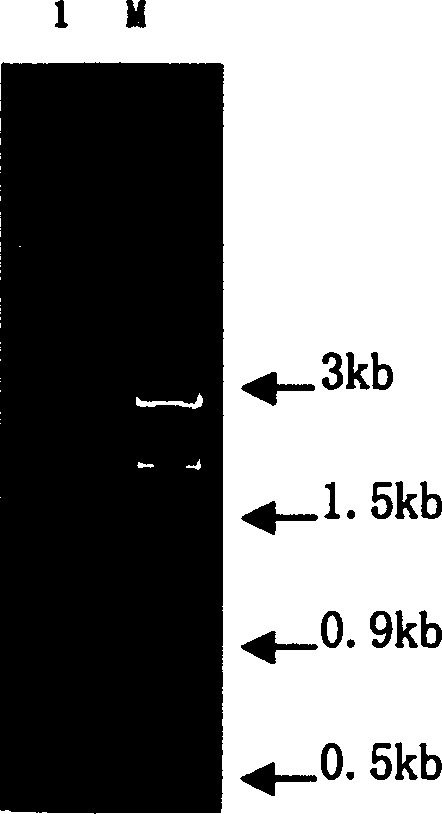Method for extracting RNA from cotton tissue
A cotton and tissue technology, applied in chemical instruments and methods, preparation of sugar derivatives, sugar derivatives, etc., can solve the problems of easy loss of RNA, can not meet the molecular biology research of cotton, etc., and achieve low price and ensure integrity. Effect
- Summary
- Abstract
- Description
- Claims
- Application Information
AI Technical Summary
Problems solved by technology
Method used
Image
Examples
Embodiment 1
[0038] Embodiment 1: utilize cotton root to extract RNA sample
[0039] (1) Take 2 grams of fresh cotton root, wash it with water and grind it into powder with liquid nitrogen; quickly transfer the sample to a centrifuge tube, and add 20 ml of pre-cooled RNA extraction buffer (pH6.0 ) (containing 0.5% PVP4000) and 200 microliters of β-mercaptoethanol, upside down to mix evenly, add 2 ml of sodium acetate, mix evenly;
[0040] (2) Add an equal volume of chloroform solution, mix upside down to make it a uniform phase, place on ice for 15 minutes, centrifuge at 12000×g for 15 minutes at 4°C, and recover the supernatant;
[0041] (3) Take the supernatant into a new tube, add an equal volume of frozen (-20°C) isopropanol to precipitate RNA, place it in a -20°C refrigerator for 30 minutes, and centrifuge at 10,000×g for 15 minutes at 4°C;
[0042] (4) Discard the supernatant, dissolve the precipitate completely with 3ml RNA extraction buffer, then add 3ml of acid phenol solution (p...
Embodiment 2
[0048] Embodiment 2: utilize cotton true leaf to extract RNA sample
[0049] (1) Take 1 gram of fresh cotton true leaves, grind it into powder with liquid nitrogen; quickly transfer the sample to a centrifuge tube, and add 15 ml of pre-cooled RNA extraction buffer (pH6.5) (containing 2 % PVP4000) and 200 microliters of β-mercaptoethanol, upside down to mix evenly, add 1 ml of sodium acetate, mix evenly;
[0050] (2) Add an equal volume of chloroform solution, mix upside down to make it a uniform phase, place on ice for 15 minutes, centrifuge at 12000×g for 15 minutes at 4°C, and recover the supernatant;
[0051] (3) Take the supernatant from step (2) into a new tube, add an equal volume of frozen (-20°C) isopropanol to precipitate RNA, and place it in a -20°C refrigerator for 1 hour, 4°C, 12000×g Centrifuge for 15 minutes to recover the precipitate;
[0052] (4) Discard the supernatant, dissolve the precipitate completely with 5ml RNA extraction buffer, then add 5ml of acid ...
Embodiment 3
[0058] Embodiment 3: extract RNA sample from cotton callus
[0059] (1) Get 0.3 grams of fresh cotton callus and put it into a glass homogenizer, and add 3 milliliters of pre-cooled RNA extraction buffer (pH6.3) (containing 0.5% PVP4000), grind it, and add 0.24 milliliters of Sodium acetate, mix well, pour into the centrifuge tube;
[0060] (2) Add an equal volume of chloroform solution, mix upside down to make it a uniform phase, place on ice for 10 minutes, centrifuge at 12000×g for 10 minutes at 4°C, and recover the supernatant;
[0061] (3) Take the supernatant from step (2) into a new tube, add an equal volume of frozen (-20°C) isopropanol to precipitate RNA, and place it in a -20°C refrigerator for 0.5 hours, 4°C, 10000×g Centrifuge for 10 minutes to recover the precipitate;
[0062] (4) Discard the supernatant, dissolve the precipitate thoroughly with 0.5ml RNA extraction buffer, then add 0.5ml of acid phenol solution (pH 4.7-5.2), mix up and down, ice bath for 10 min...
PUM
 Login to View More
Login to View More Abstract
Description
Claims
Application Information
 Login to View More
Login to View More - R&D
- Intellectual Property
- Life Sciences
- Materials
- Tech Scout
- Unparalleled Data Quality
- Higher Quality Content
- 60% Fewer Hallucinations
Browse by: Latest US Patents, China's latest patents, Technical Efficacy Thesaurus, Application Domain, Technology Topic, Popular Technical Reports.
© 2025 PatSnap. All rights reserved.Legal|Privacy policy|Modern Slavery Act Transparency Statement|Sitemap|About US| Contact US: help@patsnap.com



